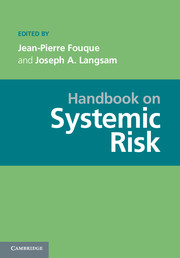Book contents
- Frontmatter
- Contents
- Contributors
- Introduction
- PART I DATA: THE PREREQUISITE FOR MANAGING SYSTEMIC RISK
- PART II STATISTICS AND SYSTEMIC RISK
- PART III MEASURING AND REGULATING SYSTEMIC RISK
- PART IV NETWORKS
- PART V SYSTEMIC RISK ANDMATHEMATICAL FINANCE
- PART VI COUNTERPARTY RISK AND SYSTEMIC RISK
- PART VII ALGORITHMIC TRADING
- 21 Market Microstructure Knowledge Needed for Controlling an Intra-Day Trading Process
- 22 Dynamical Models of Market Impact and Algorithms for Order Execution
- PART VIII BEHAVIORAL FINANCE: THE PSYCHOLOGICAL DIMENSION OF SYSTEMIC RISK
- PART IX REGULATION
- PART X COMPUTATIONAL ISSUES AND REQUIREMENTS
- PART XI ACCOUNTING ISSUES
- References
21 - Market Microstructure Knowledge Needed for Controlling an Intra-Day Trading Process
from PART VII - ALGORITHMIC TRADING
Published online by Cambridge University Press: 05 June 2013
- Frontmatter
- Contents
- Contributors
- Introduction
- PART I DATA: THE PREREQUISITE FOR MANAGING SYSTEMIC RISK
- PART II STATISTICS AND SYSTEMIC RISK
- PART III MEASURING AND REGULATING SYSTEMIC RISK
- PART IV NETWORKS
- PART V SYSTEMIC RISK ANDMATHEMATICAL FINANCE
- PART VI COUNTERPARTY RISK AND SYSTEMIC RISK
- PART VII ALGORITHMIC TRADING
- 21 Market Microstructure Knowledge Needed for Controlling an Intra-Day Trading Process
- 22 Dynamical Models of Market Impact and Algorithms for Order Execution
- PART VIII BEHAVIORAL FINANCE: THE PSYCHOLOGICAL DIMENSION OF SYSTEMIC RISK
- PART IX REGULATION
- PART X COMPUTATIONAL ISSUES AND REQUIREMENTS
- PART XI ACCOUNTING ISSUES
- References
Summary
Abstract A great deal of academic and theoretical work has been dedicated to optimal liquidation of large orders these last twenty years. The optimal split of an order through time (‘optimal trade scheduling’) and space (‘smart order routing’) is of high interest to practitioners because of the increasing complexity of the market micro structure because of the evolution recently of regulations and liquidity worldwide. This chapter translates into quantitative terms these regulatory issues and, more broadly, current market design.
It relates the recent advances in optimal trading, order-book simulation and optimal liquidity to the reality of trading in an emerging global network of liquidity.
Market microstructure modeling and payoff understanding are key elements of quantitative trading
As is well known, optimal (or quantitative) trading is about finding the proper balance between providing liquidity in order to minimize the impact of the trades, and consuming liquidity in order to minimize the market risk exposure, while taking profit through potentially instantaneous trading signals, supposed to be triggered by liquidity inefficiencies.
The mathematical framework required to solve this kind of optimization problem needs:
a model of the consequences of the different ways of interacting with liquidity (such as the market impact model (Almgren et al., 2005; Wyart et al., 2008; Gatheral, 2010));
a proxy for the ‘market risk’ (the most natural of them being the high frequency volatility (Aït-Sahalia and Jacod, 2007; Zhang et al., 2005; Robert and Rosenbaum, 2011));
and a model for quantifying the likelihood of the liquidity state of the market (Bacry et al., 2009; Cont et al., 2010).
- Type
- Chapter
- Information
- Handbook on Systemic Risk , pp. 549 - 578Publisher: Cambridge University PressPrint publication year: 2013
References
- 7
- Cited by



